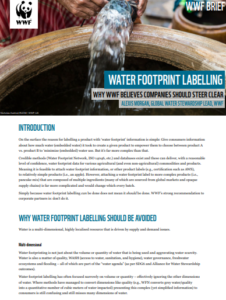Water Footprint Labelling: Why WWF Believes Companies Should Steer Clear
The concept of water footprint labeling has gained traction in recent years as a way for companies to demonstrate the water usage of their products. However, the World Wide Fund for Nature (WWF) has raised concerns about this practice. While the intent behind such labels is to inform consumers about the environmental impact of their choices, WWF believes they may be oversimplifying the issue. Water footprint labeling often focuses solely on the quantity of water used, without considering other critical factors like local water scarcity, water quality, and the broader ecosystem impacts.
WWF argues that water management is far more complex than a simple label can convey. In regions with abundant water resources, a product’s water footprint may appear negligible, while in areas facing severe water scarcity, the same product could have far-reaching negative effects. Instead of just focusing on labeling, WWF calls for a more comprehensive approach to water management, urging companies to engage in responsible water use strategies that go beyond mere numbers. They advocate for better water stewardship practices, collaboration with local communities, and more transparency in corporate water usage.
Bear Dina Exploring Her New Enclosure at FOUR PAWS
Bear Dina, a rescued brown bear, has recently experienced the joy of exploring her new, spacious enclosure at FOUR PAWS, a global animal welfare organization. Dina was previously kept in a small, inadequate cage for many years before being rescued. After months of rehabilitation, she now enjoys the freedom of a naturalistic habitat designed to mimic her wild environment.
Her new enclosure is equipped with trees, water features, and plenty of space for her to roam, forage, and exhibit natural behaviors that were previously denied to her. Dina’s story is one of resilience and recovery, and her journey highlights the importance of sanctuaries like FOUR PAWS in providing safe havens for rescued animals. By offering Dina and other animals like her a better life, organizations are helping to undo the damage caused by their past captivity and offering them the chance to live in a more fulfilling, natural way.
How Confined Dogs Lose Their Mind
Confined dogs—whether in small cages, tied up, or locked in small, barren environments—can experience severe psychological stress. Dogs are social creatures by nature and need regular interaction, mental stimulation, and physical exercise. Prolonged confinement without proper care can lead to anxiety, depression, and behavioral problems.
When dogs are kept in confined spaces for extended periods, they may begin to exhibit signs of mental deterioration. These signs can include pacing, excessive barking, destructive behavior, and even self-harm. Without sufficient mental stimulation or the opportunity to explore their environment, dogs can lose their sense of agency, leading to a breakdown in their emotional well-being. This phenomenon is often referred to as “kennel stress” or “cage rage.” To prevent these negative outcomes, animal welfare advocates emphasize the need for responsible pet ownership, ensuring that dogs have ample space, exercise, and social interaction to thrive.
The Lifeline of Animal Rescue Organizations: A Closer Look
Animal rescue organizations play a pivotal role in saving the lives of countless animals, from those abandoned in shelters to those trapped in abusive or dangerous situations. These organizations, often run by passionate volunteers, provide immediate care, medical treatment, and sometimes long-term rehabilitation for animals in need. They also work on education and advocacy, encouraging communities to adopt, spay, and neuter pets, and to consider alternatives to traditional breeding and purchasing practices.
Rescue organizations face numerous challenges, including funding shortages, limited resources, and the emotional toll of dealing with cases of severe abuse or neglect. Despite these obstacles, their efforts remain crucial to the welfare of animals. Whether it’s through providing sanctuary for abused animals, rescuing strays from dangerous situations, or pushing for stronger animal protection laws, these organizations serve as lifelines, offering hope and a second chance for many animals in dire need.
Without the work of animal rescue groups, the scale of the animal welfare crisis would be even more dire. The dedication and selflessness of the individuals involved in these organizations continue to be a source of inspiration and a testament to the power of compassion.



